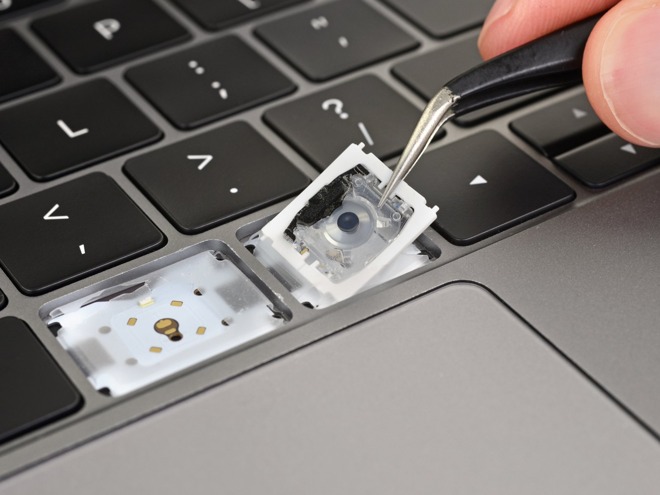2019 MacBook Pro keyboard changes don't look like they're going to do much
A teardown of the newly-released 2019 MacBook Pro finds that Apple has made some changes to switch covers and to the dome switches themselves, but it isn't clear what, if anything, the material shift will do to alleviate keyboard complaints.

Fourier Transform Infrared (FTIR) spectroscopy shows that switch covers for the keyboard have moved to polyamide -- nylon -- from the polyacetylene with aromatic urethane side groups used in 2018 Pros, iFixit said on Friday. The metal dome switches for the keyboards also appear to have changed, whether through new surface treatments or a new alloy. It could be ferritic stainless steel with a thin polymer coating.
If those domes crack or deform, keyboards can malfunction, iFixit noted. Apple's changes are likely to deal with long-standing complaints about MacBook keys double-typing or becoming unresponsive. A free repair program was recently extended to more MacBooks.
The company promised enhanced butterfly keyboards when launching the new Pros earlier this week, but has been relatively vague on what's actually been done.
Apple doesn't appear to have made any changes to address the thermal situation inside the MacBook Pro, and repairability is still minimal, iFixit added. While the trackpad can be replaced with little effort, the processor, RAM, and SSD are soldered to the logic board.
The entire top case assembly -- including the battery, keyboard, speakers, and Touch Bar -- is glued together as it has been since the 2012 Retina MacBook Pro. Additionally, since the Touch ID sensor doubles as the power switch and is linked with Apple's T2 coprocessor, simply fixing that switch may force people to go to Apple or get a new logic board.

Fourier Transform Infrared (FTIR) spectroscopy shows that switch covers for the keyboard have moved to polyamide -- nylon -- from the polyacetylene with aromatic urethane side groups used in 2018 Pros, iFixit said on Friday. The metal dome switches for the keyboards also appear to have changed, whether through new surface treatments or a new alloy. It could be ferritic stainless steel with a thin polymer coating.
If those domes crack or deform, keyboards can malfunction, iFixit noted. Apple's changes are likely to deal with long-standing complaints about MacBook keys double-typing or becoming unresponsive. A free repair program was recently extended to more MacBooks.
The company promised enhanced butterfly keyboards when launching the new Pros earlier this week, but has been relatively vague on what's actually been done.
Apple doesn't appear to have made any changes to address the thermal situation inside the MacBook Pro, and repairability is still minimal, iFixit added. While the trackpad can be replaced with little effort, the processor, RAM, and SSD are soldered to the logic board.
The entire top case assembly -- including the battery, keyboard, speakers, and Touch Bar -- is glued together as it has been since the 2012 Retina MacBook Pro. Additionally, since the Touch ID sensor doubles as the power switch and is linked with Apple's T2 coprocessor, simply fixing that switch may force people to go to Apple or get a new logic board.


Comments
Instead of playing the wait and see approach, let's just jump to conclusions and bitch about the keyboard instead.
There are some numbers that you're looking for in the first keyboard failure rate piece we did. https://appleinsider.com/articles/18/04/30/2016-macbook-pro-butterfly-keyboards-failing-twice-as-frequently-as-older-models
I can’t recall ever having a keyboard failure on anything that’s younger than 30 years old. My only problematic keyboard is attached to a second-hand Atari ST.
So, we're comfortable in saying so. It's also pretty telling that the 2019 model is already listed on the four-year REA for the keyboard.
As keyboards are (still) mechanical they will always have the potential for mechanical failure. But I am happy that Apple has extended the keyboard warranty (although I don't believe I will ever need it) and expect to keep this MBP for 5-7 years before next replacement.
This will save them time and money, but doesn't look like it will help the end-user. What it doesn't look like it's going to do at all is cut back on Genius Bar visits.
Our opinion on the keyboard hasn't changed. It is a low percent of users that are seeing failures. It is also, at the same time, higher than it should be.
On topic:
Here's to hoping the changes help mitigate the keyboard issues for future buyers. The headline imo, though provocative, does seem to mirror Apple's confidence in the "fix" since this keyboard has been preemptively added to the repair program. This seems like the 3rd mitigation to be thrown against the wall with the hopes that it will stick. If it doesn't... oh well, it 's already in the program.
As for expressing an opinion now. The original was flawed. So was the replacement. As was the replacement's replacement...and the replacement's replacement's replacement. Why would one have confidence this latest fix is going to be the One. I mean, if it was code named Neo during development I'd have some optimism. This fix seems more like a fingers crossed, hope this works kinda deal.